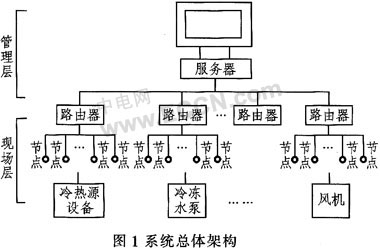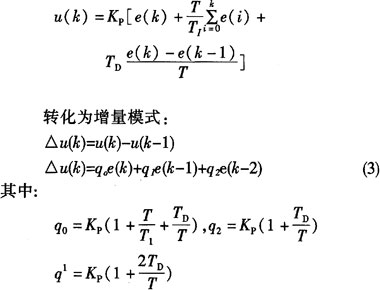| 1 Introduction With the advancement of science and technology and social development, air-conditioning technology is changing with each passing day. Large-scale buildings such as various units, buildings and hotels have adopted centralized air-conditioning systems with advanced technology, energy conservation and environmental protection. However, due to the advanced and mature control technology of foreign centralized air-conditioning systems, they occupy the market. Monopoly. Today, LonWorks technology is widely used, and it is necessary to seize the rare opportunity to develop a centralized air-conditioning system based on LonWorks technology with its good compatibility and scalability, breaking the monopoly of foreign countries. Considering the advantages of LonWorks technology, this paper designs a centralized air conditioning system based on LonWorks technology. 2 LonWOFks Technical Brief LonWorks is a comprehensive fieldbus measurement and control network launched by Echelon, also known as Local Operation Network (LON). LonWorks technology has a complete platform for developing and controlling network systems, including all the hardware and software needed to design, configure, and maintain a control network. The basic unit of the LonWorks network is a node, and one network node includes a Neuron Chip, a power supply, a transceiver, and an I/O circuit for connecting the monitoring device interface. Lonworks adopts all 7-layer communication protocols of ISO/OSI model, adopts object-oriented design method, and simplifies network communication design to parameter setting through network variables, which is easy to realize network interoperability; its communication rate is from 300 b/s It can reach 1.5 Mb/s and the communication distance is up to 2700 m. It supports multiple communication media such as twisted pair, coaxial cable, optical fiber, radio frequency, infrared, power line, etc., and develops corresponding intrinsic safety products. 3 Overview of centralized air conditioning systems Centralized air conditioning systems (also known as centralized water conditioning systems) include air systems, water systems, central heating/cooling equipment rooms, and control systems. The air system (also known as the air handling system) includes an air handling unit, a supply and exhaust duct, a fan drive box, an air distribution device, and an exhaust system for regulating, conveying, distributing the treated air, recirculating air, and outdoor Fresh air and venting air, control the indoor environment according to indoor requirements; water system includes chilled water system and hot water system, cooling water pump and hot water pump, cooling water system and cooling water pump, used to send chilled water and hot water from the machine room to the air Dispose of the unit and fan drive box, and deliver cooling water from the cooling tower, well or Other water source to the central equipment room. The central equipment room includes heat source equipment and cold source equipment to reduce the temperature of the chilled water without heating to hot water or steam. The control system includes electronic sensors, microprocessors, etc., for controlling related equipment. 4 LonWorks-based centralized air conditioning system 4.1 System Architecture The system is designed for a centralized air-conditioning system in an institution's compound. There are 1 000 points to be controlled. Considering the future expansion and upgrade, a two-layer structure is adopted, which is the management layer and the field control layer. The overall architecture of the system is shown in Figure 1.
The management bus uses the TCP/IP protocol layer based on LonWorks to complete the monitoring of the entire system, which is implemented by a computer. The router connects LonWorks information between different channels to implement network traffic control, divide different network segments, and increase network capacity. The main functions of the management are to set system parameters, detect the status of the central air conditioning system control node, dynamically display electronic map data, print alarm reports and status analysis, and collect and record real-time data. The field layer is mainly composed of intelligent nodes and field devices, and is the basis of the entire system. The intelligent node is connected to the on-site air conditioner, water pump, cold and heat source equipment through the LonWorks bus. Receive digital and analog signals collected in the field, control the field devices according to the programmed program and the parameters set by the management layer, and feed all signals back to the management layer. 4.2 Hardware Design The hardware structure diagram of the intelligent node of the centralized air conditioning system is shown in Figure 2.
4.2.1 CPU The CPU of the intelligent node uses the Neuron TMPN3150 neuron chip. The Neuron chip provides complete system resources and integrates three CPUs internally. The first one is used to implement Layer 1 and Layer 2 functions in the Open Interconnect Model, called Media Access Control Processor, for media access control and processing. The second is used to complete the functions of layers 3-6. It is called network processor, used for addressing, processing, background diagnosis, path selection, software timing, network management of network variables, and is responsible for network communication control, sending and receiving data packets, etc. The third is the application processor. Execute operating system services and user code. The Neuron chip provides 11 I/O pins and can be configured with up to 34 I/O objects (ie, input and output). In this system design, I/O0~I/O2 are set as outputs, which respectively drive the relays or actuators of fans, pumps and water valves, and I/O3~I/O11 are set as inputs to collect field device status, alarm, etc. data. 4.2.2 Program Memory The Neuron TMPN3150 neuron chip has no internal ROM but has an external memory interface with an address space of up to 64 KB. The system uses PSD9xx memory with programmable logic, expandable transceiver and corresponding peripheral circuits, thus forming a multi-function modular interface with analog, analog, open, open, pulse, RS-232 and other modular interfaces. The LonWorks network node, the PSD9xx series of memory also adds a neuron chip. The I/O capacity and storage capacity can increase the number of I/O ports of the neuron chip from 11 to 21. The TMPN3150 operates as an address/data non-multiplexed 8-bit data bus. 4.2.3 Transceiver The signal line powered transceiver FTT-10A, a free-topology twisted pair transceiver with a communication speed of 78 kb/s and transformer isolation coupling. The transceiver provides a physical communication interface between the neuron chip and the LonWorks network. 4.2.4 Other circuits Crystal Oscillator Circuit: Provides a working clock for the neuron chip. Reset circuit: used for resetting when the smart node is powered. Service circuit: Includes Service button and Service indicator. The Service button is specifically designed to install the smart node to the network. The Service indicator is used to indicate information when diagnosing the firmware status of the neuron chip. 4.3 Software Design 4.3.1 Introduction to Software Design The software program of the intelligent node is written in Neuron C language. It is naturally extended on the basis of the standard C and directly supports the firmware of the Neuron chip. It includes a multitasking scheduler that uses an event-driven programming structure, so the software functions of the entire node are driven by several events. These include: reset events, which mainly complete initialization of some variables of the system; timer overflow events, complete 50 ms timing loop acquisition I/O events, including receiving alarms, collecting temperature, traffic, etc.; network variable update events, obtaining other The information of the node and the network variables modified by the server. 4.3.2 PID control algorithm and program design The system includes control of cold and heat source equipment, air conditioner, fan coil, water pump, pressure fan, etc. The control method involved is mainly PID control. Here is an example of the calculation method of the water valve PID adjustment which is the most used in the system. The implementation of the program. In the industrial control system, the analog PID control system is often used, and its control law is as follows:
Among them, KP is the proportional gain, TI is the integral time constant, TD is the differential time constant, u(t) is the control quantity, and e(t) is the deviation. To facilitate program control and programming, a digital incremental PID control system is employed. As shown in Figure 3.
Replace equation (1) with a difference equation and approximate it:
T is the sampling time. Considering that the water valve controls the fan supply air temperature by adjusting the flow of hot and cold water, the set temperature is generally unchanged, which is a first-order constant value control system. Referring to the engineering practice, KP=4, KI=KP(T/TI)=0.02KP, KD=0. The sampling time T can be modified by itself during programming. Here, 1 s, e(k) is the temperature difference, and the unit is °C. The digital PID incremental control algorithm flow is shown in Figure 4.
5 Conclusion The centralized air conditioning system uses LonWorks technology for communication and control to meet anticipated control requirements. The centralized air conditioning system developed by Lonworks technology has high reliability, easy maintenance, high performance and price ratio, and can easily expand and upgrade system functions to meet the actual needs of the project. | ||||||
references:
[1]. ROM datasheet http://
[2]. PSD9xx datasheet http://
[3]. RS-232 datasheet http://
:
Huerler Lighting Equipment Co., Ltd , http://www.sz-ledlights.com





